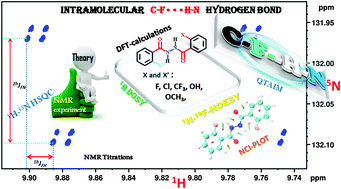Intramolecular hydrogen bonds involving organic fluorine in the derivatives of hydrazides: an NMR investigation substantiated by DFT based theoretical calculations†
Abstract
The rare examples of intramolecular hydrogen bonds (HB) of the type the N–H⋯F–C, detected in a low polarity solvent in the derivatives of hydrazides, by utilizing one and two-dimensional solution state multinuclear NMR techniques, are reported. The observation of through-space couplings, such as, 1hJFH, and 1hJFN, provides direct evidence for the existence of intra-molecular HB. Solvent induced perturbations and the variable temperature NMR experiments unambiguously establish the presence of intramolecular HB. The existence of multiple conformers in some of the investigated molecules is also revealed by two dimensional HOESY and 15N–1H HSQC experiments. The 1H DOSY experimental results discard any possibility of self or cross dimerization of the molecules. The derived NMR experimental results are further substantiated by Density Function Theory (DFT) based Non Covalent Interaction (NCI), and Quantum Theory of Atom in Molecule (QTAIM) calculations. The NCI calculations served as a very sensitive tool for detection of non-covalent interactions and also confirm the presence of bifurcated HBs.


 Please wait while we load your content...
Please wait while we load your content...